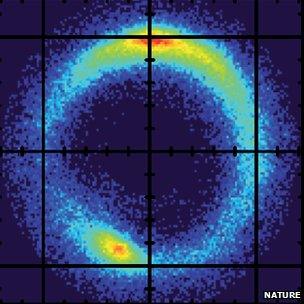Dark matter galaxy hints seen 10bn light-years away
- Published

The light bent by a dark-matter-dominated galaxy can form what is known as an "Einstein ring"
Astronomers have spotted a "dwarf" galaxy some 10 billion light-years away which may be made mostly of the mysterious material called dark matter.
The dwarf was found using a technique called gravitational lensing. It is only the second dark dwarf ever seen, and it is by far the most distant.
The fact that so few dwarf galaxies are seen in our own cosmic neighbourhood has remained a conundrum in astronomy.
The study in Nature could explain it: they may be overwhelmingly dark matter.
Dwarf galaxies often occur in the periphery of larger galaxies, where they are known as satellites - the Milky Way may have many as well.
"According to the theory of galaxy formation, you'd expect thousands of these satellites," explained lead author of the study Simona Vegetti of the Massachusetts Institute of Technology.
"But if you look at the Milky Way we only find 30, so it's important to understand how many satellites are really there, and important to look at other galaxies other than the Milky Way," she told BBC News.
That will help determine if our cosmic neighbourhood of galaxies - the Local Group - is unusual, or if the theory of galaxy formation is incomplete.
Massive question
Dark matter is so named because it does not interact with light - it cannot be seen directly, as the stars and dust of the cosmos can.
However, it does have mass - making up 85% of the mass in the Universe - and the effects of that mass can be spotted.
Gravitational lensing is a technique in which an object that lies between Earth and a distant light source can actually act as a "lens"; the object's mass bends the distant galaxy's light, magnifying and distorting it.
By using computer models of how that magnification and distortion should work, the mass of the lensing galaxy - and where that mass is distributed - can be determined.
The technique was recently used to develop the widest view of dark matter distribution in the Universe ever produced.
Dr Vegetti and colleagues in the US and the Netherlands have now used the Keck telescope in Hawaii to study the lensing caused by a distant elliptical galaxy called JVAS B1938+666.
They found a discrepancy in comparing with the image that their detailed computer model suggested should come from the system.
Something with a mass about 200,000,000 times that of our Sun is in the periphery of the image they see.
Yet that source of mass is not visible in the image of the galaxy itself.
"It's very hard to tell at the moment because the telescopes are just not powerful enough to see such dim galaxies so far away," Dr Vegetti said.
"But [the dwarf galaxy] is most likely dominated by dark matter, or maybe there are a few stars hiding here and there."
The team must continue the hunt for such satellites to get to the bottom of the dark mystery.
"We were kind of lucky that the first one we looked at also had a satellite," Dr Vegetti said.
"If we find other galaxies or satellites, it will tell us whether we need to change the properties of dark matter; if we don't find enough, then dark matter must be different from what we think."
- Published9 January 2012
- Published14 January 2011
- Published16 September 2011
- Published7 September 2010